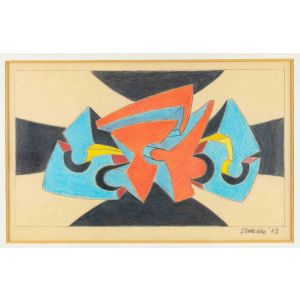Obelisco Egizio
Obelisco Egizio (Egyptian obelisk erected by Pope Sixtus V) is a wonderful black and white etching on fine laid and watermarked paper (with a lily inside a double circle, watermark n. 2 according to Hind) realized by Giovan Battista Piranesi .
Signed on plate on the lower right margin " Piranesi Architetto fec. " Second State/V (Hind 53) .
Excellent conditions, except for a usual medial fold of paper, visible only on the left margin.
From one of the most important series of etchings by G.B. Piranesi, Views of Rome drawn and etched by Giambattista Piranesi, Venetian Architect (1753), this wonderful specimen with a lifetime impression represents an Egyptian obelisk erected by Pope Sixtus V. This artwork has wide margins and a detailed caption (on plate) describing the monument.
Address and price on lower left margin.
Obelisco Egizio (Egyptian obelisk erected by Pope Sixtus V) is a wonderful black and white etching on fine laid and watermarked paper (with a lily inside a double circle, watermark n. 2 according to Hind) realized by Giovan Battista Piranesi .
Signed on plate on the lower right margin " Piranesi Architetto fec. " Second State/V (Hind 53) .
Excellent conditions, except for a usual medial fold of paper, visible only on the left margin.
From one of the most important series of etchings by G.B. Piranesi, Views of Rome drawn and etched by Giambattista Piranesi, Venetian Architect (1753), this wonderful specimen with a lifetime impression represents an Egyptian obelisk erected by Pope Sixtus V. This artwork has wide margins and a detailed caption (on plate) describing the monument.
Address and price on lower left margin.
Views of Rome
Executed over the course of Piranesi's long career, from the second half of the 1740s until his death, Views of Rome was printed and sold as individual sheets or in collections that gradually enlarged as his production progressed, and it occasionally included other print series as well. A posthumous edition, bearing the same title, consists of 135 prints engraved in 1778 plus 2 title pages. The additions consisted of Pianta di Roma e del Campo Marzio and 2 plates made by his son, Francesco Piranesi.
Background:
In 1740, Giovanni Battista Piranesi arrived in Rome for the first time and was left speechless by the Eternal City’s outstanding beauty. He did apprenticeships with Valeriani’s and then with Giuseppe Vasi’s workshops. The Sicilian engraver and vedutist Giuseppe Vasi taught Piranesi the etching technique, transferring his passion for graphic art to the Venetian old master.
Reference:
A. Hind, Giovanni Battista Piranesi, A Critical Study , Holland Press, London, 1922, n. 53;
L. Ficacci, Piranesi, The Complete Etching , Taschen, p. 703, n. 902.












































Validate your login
Sign In
Create New Account